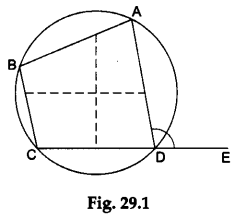Math Labs with Activity – Cyclic Quadrilateral
OBJECTIVE
To verify that
- the opposite angles of a cyclic quadrilateral are supplementary, and
- if one side of a cyclic quadrilateral is produced then the exterior angle is equal to the opposite interior angle.
Materials Required
- A piece of cardboard
- A sheet of white paper
- A sheet of glazed paper
- A sheet of tracing paper
- A geometry box
- A pair of scissors
- A tube of glue
Theory
A quadrilateral whose all the four vertices lie on the circumference of the same circle is called a cyclic quadrilateral. In a cyclic quadrilateral, the opposite angles are supplementary and the exterior angle (formed by producing a side) is equal to the opposite interior angle.
Procedure
Step 1: Paste the sheet of white paper on the cardboard.
Draw a circle of any radius on this sheet and also draw a cyclic quadrilateral ABCD.
Step 2: Produce the side CD of the cyclic quadrilateral ABCD to E. Mark the exterior angle ∠ADE (see Figure 29.1).

Step 3: Make an exact replica of the quadrilateral ABCD on a glazed paper using the tracing paper. Also, make a replica of ∠ADE on the tracing paper.
Step 4: Cut out the quadrilateral ABCD made on the sheet of glazed paper and further cut it into four parts such that each part contains one of the angles ∠A, ∠B, ∠C and ∠D (see Figure 29.2)

Step 5: Place ∠A and ∠C adjacent to each other (as in Figure 29.3).’What do you observe?

Step 6: Place ∠B and ∠D adjacent to each other (as in Figure 29.4). What do you observe?

Step 7: Place the replica of ∠ADE (which you have on the tracing paper) on ∠B of the quadrilateral ABCD on the sheet of white paper. What do you observe?
Observations
- When ∠A and ∠C are placed adjacent to each other, they form a linear pair, i.e., ∠A + ∠C = 180°.
- When ∠B and ∠D are placed adjacent to each other, they form a linear pair, i.e., ∠B + ∠D = 180°.
- When ∠ADE is placed over ∠B, it covers ∠B completely, i.e., ∠ADE = ∠B.
Result
It is verified that
- the opposite angles of a cyclic quadrilateral are supplementary, and
- if one side of a cyclic quadrilateral is produced then the exterior angle is equal to the opposite interior angle.
Remarks:
The above results are true only for a cyclic quadrilateral.
Math Labs with ActivityMath LabsScience Practical SkillsScience Labs
